by Kenan White | Jul 10, 2012 | Basics, Gardening, Miscellaneous |
Many people find themselves asking the question, “why use Latin to classify?” When you consider that there are over 250,000 species of living plants worldwide, it makes sense to have chosen a single language to label all these plants. This use of Latin allows gardeners and botanists to speak a universal language when talking about plants. This classification uses a binomial, or two name, system.
The genus is always first and is always capitalized. You may think of the generic name as you would a family name: Smith, Jones or Brown. There are broad grouping of similar plants. These names are almost always derived from the Greek language, but often it is derived from the place it was discovered or even the discoverer themselves. Occasionally, the name comes from legend or mythology. For example, Mint’s genus name is Mentha.
The species comes second and is usually lowercase. Mint’s genus name is Mentha, and if we use Spearmint to further our example, its species name is spicata. Therefore, Spearmint’s binomial classification is ‘Mentha spicata.’
If there is a variation in a species, it is denoted by “var.” Also, if there is a subspecies, it comes third.
Once a plant is cultivated or selected for a certain virtue, then the new plant is considered a ‘cultivar.’ These names are capitalized in single quotation marks.
Hybrids are plants resulting from sexual reproduction between two different types of plants. Hybrids are denoted by an “x.”
Lastly, many plants will be given a common name – this is similar to a nickname and is not a correct or scientific name. Below are a few examples of plants, their nicknames and their Latin names.
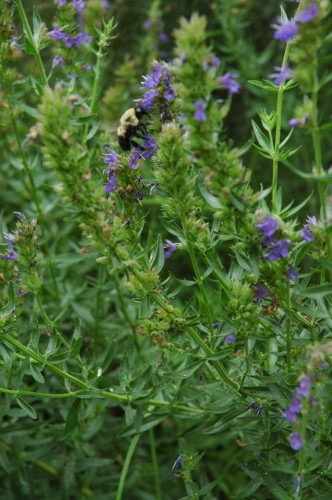
Hyssop or “Agastache foeniculum”
by Kenan White | Jul 2, 2012 | Miscellaneous |
Dear Friends:
When we began our nursery in 1987, we were selling plants in our local market – we knew each and every customer and they knew us. They trusted us to provide them with the highest quality plants at a fair price.
They also trusted us to grow their plants ‘right’. We have followed that philosophy for the past 25 years and it includes everything we do, both on the farm, in the green house, as well as shipping plants to our customers.
When we went onto the world wide web in 2008, we made a whole new group of friends – our customer base is now over 20,000 – we can’t know every customer but we can sure make it our business to make sure that you know exactly WHO we are and WHAT we stand for and HOW we grow…..
After 30 years of growing and selling plants we have often been asked if we are organic. Technically the answer is no, we are not certified “organic.” However, we follow many practices that are considered organic. The only thing we lack is official certification from the government. Instead, we like to refer to our growing practices as “natural.” Growing naturally, like growing organically, requires more labor than conventional growing. All of our plants are safe to eat as soon as your receive them because they have never known harmful chemicals.
It is important to us that our customers receive happy, healthy plants and we want to provide satisfaction without harming our environment. We also believe our customers have a right to know how their plants are grown and our philosophy is that plants should be “Grown Right.” This is not just some catchy tag line that a PR firm came up with, but a simple philosophy we have followed since the beginning. When we went on the web, we wondered how we could show our new friends that our products were being grown right. The Growers Exchange had always provided high quality plants that were grown right, and we had no intention of changing our values because we moved to the Internet. We want to share our philosophy with you.
What “Grown Right” means to us:
- Many people ask if we used genetically modified seeds, and the answer is no. We plant only the best seeds available from select seed houses.
- The Growers Exchange uses only biodegradable chemicals derived from natural resources, so our plants have never been touched by harmful chemicals. Instead of harsh chemicals, we opt for alternatives such as hot pepper wax and zeretol. The proof of our natural growing practices is evident by the critters we see running around our greenhouses. Baby bunnies, tree frogs, toads and black snakes all use the warm greenhouses as homes. They are able to do this because they will not be harmed by any harsh chemicals or pesticides flowing through the air.
- Herbs tend to have a wild growth habit and are hard to grow as a potted plant. To keep our plants shaped for symmetrical growth, we have to hand prune. Hand pruning makes sure each plant is touched by human hands several times during the growing process. Our close contact with our plants allows us to nip any sort of insect problem in the bud before it becomes a real problem. If a plant is in danger of becoming infested, we use a quick spray of an insecticidal soap, rather than spraying the whole crop with harsh pesticides.
- The plants are kept healthy with compost from our own pile rather than receiving nutrients from chemical fertilizers.
Our views on natural growing processes are also evident in the way we package and ship our plants. Every one of our plants is grown in either recycled or recyclable plastic pots. When you receive your plants, they are packed in biodegradable materials and the boxes are recyclable. The Growers Exchange strives to use biodegradable packing materials like cornstarch peanuts.
As said before, growing right takes more time and effort than conventional growing. To us, the extra labor is worth it because we believe in raising strong, healthy plants while still protecting the environment.
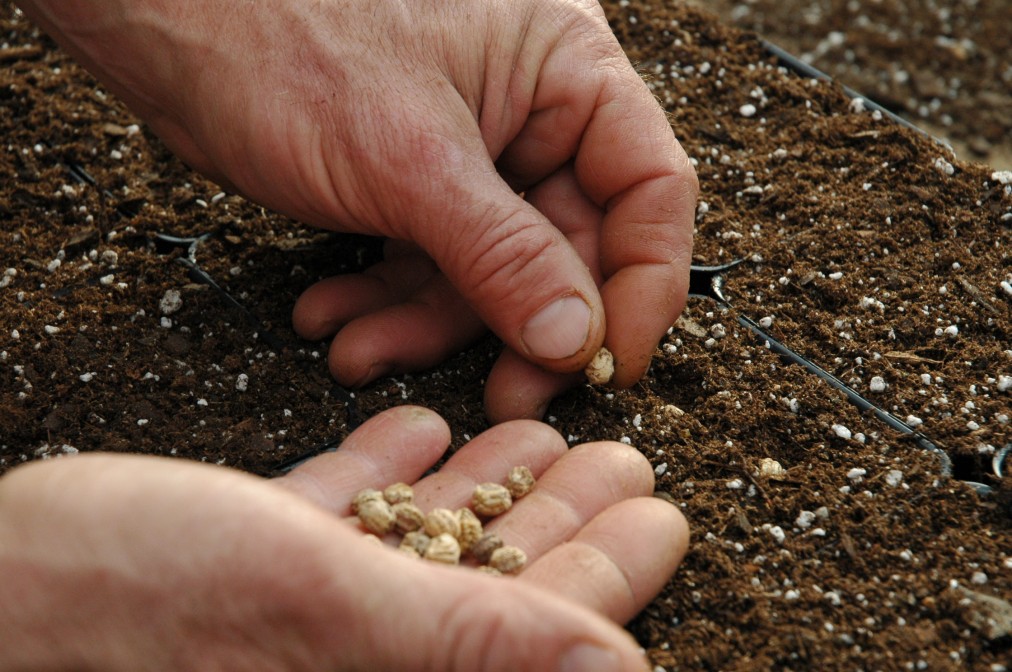
by Kenan White | Jun 12, 2012 | Herbs, Miscellaneous |
As summer quickly approaches, we have all been plagued with a common annoyance: mosquitoes. Is it my imagination, or are these pesky critters getting bigger and hungrier? So many people I know are getting companies like Mosquito Authority of Norman to help get rid of them because they are becoming such an issue! On top of this, there are also many natural ways to repel these insects using your herb garden.
Citronella (photo below) is the most commonly known plant for repelling those nasty mosquitoes. This perennial’s scent masks the smell of the mosquito’s target, making it hard for mosquitoes to locate us! It is used in many insect repellents, but the scent of the living plant is stronger and more effective. Just a quick rub of the leaf emits the fragrance. Citronella can be found as a small, potted plant but if planted into the ground, it can reach 5-6 feet.
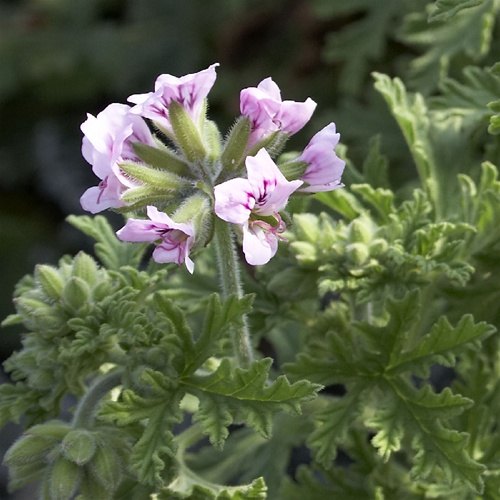
Horsemint is another perennial that also gives off a strong, masking scent to hide us from the ‘skeeters. This perennial does well in dry, sandy soil and can be found in coastal climates. Horsemint is good to have in your herb garden for more reasons than one. Not only will it repel the mosquitoes, but it will also attract butterflies!
Though they are beautiful in color, Marigolds also produce a scent that mosquitoes find repellent. Use these annuals as a border plant for patios and walkways to deter mosquitoes in their tracks! Planting marigolds around areas frequented by mosquitoes can create a barrier. Did you know that the mosquito’s saliva is what causes the itch? Yuck! Try planting them in front of open windows to keep insects out of the house! But be careful! The bright colors might attract wasps!
On a recent vacation, we were attacked over and over again by mosquitoes so we decided to do a little research. As it turns out, mosquitoes are attracted to the scents we emit. These scents we emit also explain why some people get bitten more than others. Mosquitoes can smell the carbon dioxide are emitting, as well as our bodily scents. So, the more carbon dioxide you breathe out, the more attractive you are to mosquitos! Having some of these herbs and perennials in your garden can help by covering up those tasty smells and making us almost invisible to mosquitoes! I keep many of these plants on and around my patio during the summer. I even bring them inside in the winter so they will be healthy and big when summer and ‘skeeter season rolls around again!
by Kenan White | May 21, 2012 | Books & Design, Flowers, Gardening, Herbs, Life on the Farm, Miscellaneous, Wildlife |
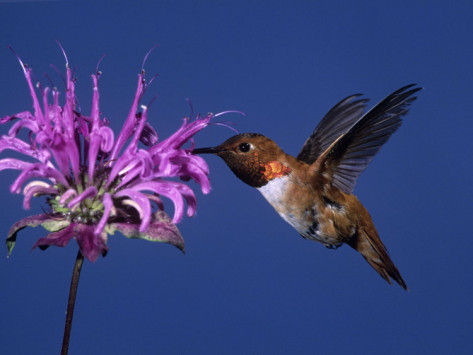
Hummingbirds love sweet,tubular-shaped flowers like those of the Bee Balm herb plant.
We absolutely LOVE watching hummingbirds dart through our gardens on a warm Summer evening. Attracting hummingbirds to your garden is a wonderful way to enjoy seeing these fast-flying little birds’ aerial antics up close, and will provide you with hours of entertainment from Spring until Fall. Also a very beneficial garden companion, hummingbirds will eat bugs and help increase pollination in your garden be flitting from bloom to bloom.
Hummingbirds do not have a sense of smell, and are instead attracted to brightly colored (usually red), trumpet or tube shaped flowers which their long beaks are specially designed to drink from. Because hummingbirds fly so fast (up to 30 miles per hour!), they spend most of their time foraging to keep their energy levels high. Their need for fuel is so high that hummingbirds may drink up to eight times their body weight in nectar in a day!
Make sure to plant these hummingbird friendly herbs and flowers to make your garden a great place for hummingbirds to feed:
We also have a variety of hanging and staked feeders that are specially designed to attract hummingbirds. Made from recycled glass, the colors change from a lovely orange and yellow color to a vibrant flame red that hummingbirds are drawn to. Click here to view our video and watch the hummingbirds swarm these lovely, hand crafted feeders.
Other tips for creating a hummingbird haven in your yard:
- Place hummingbird feeders near your garden to attract hummingbirds to your plants.
- Place the feeders at different heights throughout your yard and garden, as some species prefer different feeding patterns. Placing feeders in different parts of your yard will help keep territorial males from dominating all of the nectar.
- Make sure to keep your feeders clean and full of fresh nectar to ensure that the hummingbirds don’t get sick. Cleaning the sugary substance from the feeder’s holes may also help prevent attracting bees or wasps, as they may convene to find leftovers.
- Make sure to offer a good, clean water source for the hummingbirds to drink and bathe in, such as a bird bath which is shallow enough for them to play in.
- Add strings that run the length of your garden, above your plants to give hummers something to perch and rest on while flitting from flower to flower.
by Kenan White | May 3, 2012 | Books & Design, Containers, Exploring, Gardening, Growing, Herbs, Inspiration, Life on the Farm, Miscellaneous, Recipes |
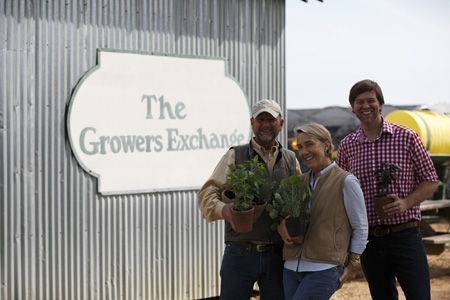
We had a great time showing James all around the farm- we even sent him home with some potted herb souvenirs!
Last week, our good friend, James Farmer came up for a demonstration on garden to table living and while here, he stayed in the cottage on our farm. We had a wonderful time strolling through the test gardens, talking about his favorite culinary herbs for his infamous Southern recipes, and chatting about country life, gardening and everything in between!
In the greenhouse, James discovered the benefits of Holy Basil and even helped us pot his very own herb garden kit, the James Farmer’s Favorites Herb Collection, where he includes his favorite culinary herbs for making his delicious drinks and dishes.
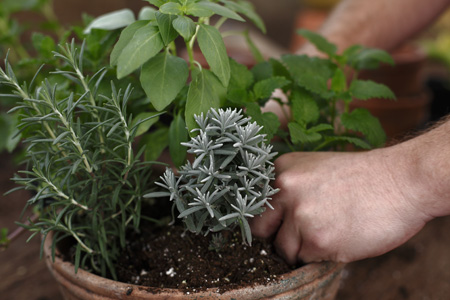
Our newest herb kit, the James Farmer's Favorites Herb Collection was hand picked by James himself!
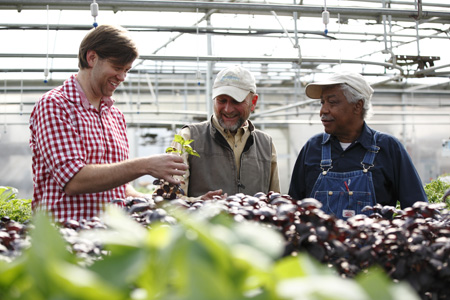
We introduced James to Holy Basil and taught him about its rich history and wonderful medicinal benefits.
When walking through the test gardens, we discussed the investment and versatility that perennial herbs lend. For example, I showed James that more than just a beautiful flower for the garden or in arrangements, Pyrethrum is a natural insect repellent and is used in many organic insecticides.
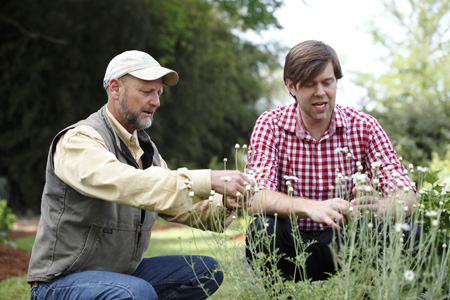
"Pyrethrum is beautiful in the garden or in arrangements, and is also a natural insect repellent used in many organic insecticides."
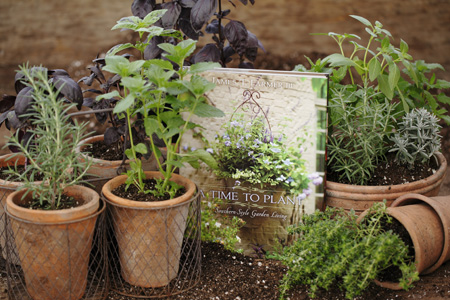
You can purchase James’s book, A Time To Plant: Southern-Style Garden Living and get loads of design tips, recipes and more, AND six of his favorite culinary herbs to create endless concoctions and dishes when you buy the James Farmer’s Favorites Herb Collection and Book!

We had such a wonderful time with James on the farm, we can't wait until he comes for another visit!
We had a such a fantastic time with James and can’t wait for him to come back! For more information on James, or his newest release, Sip and Savor: Drinks For Party and Porch, please visit his website!
by Kenan White | Apr 25, 2012 | Basics, Books & Design, Flowers, Gardening, Herbs, Inspiration, Life on the Farm, Miscellaneous, Recipes |

We are so excited that our good friend, James Farmer is coming to visit and stay at our farm this week! As part of Virginia’s Historic Garden Week, James is coming to visit and give us an exclusive demonstration on his garden to table arrangements as well as share some of his favorite food and drink recipes from his two books, A Time To Plant: Southern-Style Garden Living, and Sip and Savor, Drinks For Party and Porch, which was just released. James has a wonderful eye for design and has used his talents to bring gardening to a gourmet level. Throughout his elaborate table settings, stunning arrangements and in his Southern-chic food and drink recipes, James incorporates his passion for herb gardening for a refined but “down home” feel. As the most creative new personality in the garden living world, James still stays true to his Southern roots, drawing his inspiration from his family farm in Kathleen, Georgia.
![Time-Plant-Cover-02[1]](https://theherbexchange.com/content/uploads/2012/04/Time-Plant-Cover-021-388x500.jpg)
James Farmers Favorites
To celebrate James’s visit to our farm and his fantastic new book, A Time To Plant, Southern Style Garden Living, we’ve created the James Farmer’s Favorites Herb Collection to offer some of his favorite herb plants! We’ve included Lavender ‘Hidcote’, for its beauty in arrangements or as a garnish, and for its wonderful fragrance and light, floral flavor in drinks and recipes. For a true Southern experience, we added ‘Kentucky Colonel’ Mint, a robust spearmint that grows effortlessly and is the key component to a real Southern tradition, the Mint Julep. ‘Lemon Sweet Dani’ Basil was chosen for its delicate citrus tones and lovely blooming spires, making it perfect for flavoring seafood, salads and garnishing summer desserts. To share a savory note, we also added our Rosemary ‘Arp’, a flavorful, cold hardy, Rosemary that seasons meats, stews and full flavored desserts. (James loves using the Rosemary twigs as skewers for adding fruit kebabs to his delectable drinks!) Rounding out his favorites, are ‘Italian Flat Leaf’ Parsley for its full body flavor and lovely leafy foliage, and ‘English’ Thyme, a classic culinary herb that grew in his grandmother’s kitchen garden and of which he has fond, flavorful memories.
We have even included the option to buy either this collection of six culinary herb plants to get your garden started with Southern style, or the James Farmer’s Favorites Herb Collection AND James’s new book, A Time To Plant, Southern-Style Garden Living, for a lovely added gift.
If you may already have these wonderful culinary herbs in your garden, you can purchase A Time To Plant: Southern-Style Garden Living sold separately. Whether you treat yourself or give this as a thoughtful gift, the James Farmer’s Favorites will be a sure delight for entertaining in the garden and in your home!












![Time-Plant-Cover-02[1]](https://theherbexchange.com/content/uploads/2012/04/Time-Plant-Cover-021-388x500.jpg)